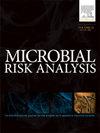Quantitative data and models for bacterial cross-contamination in domestic kitchen during food handling and preparation
IF 4
4区 环境科学与生态学
Q2 ENVIRONMENTAL SCIENCES
引用次数: 0
Abstract
Cross-contamination is a significant factor contributing to outbreaks of foodborne diseases and food spoilage, and is an important component of quantitative microbial risk assessment (QMRA). The domestic environment represents the final stage of exposure assessment, and data underscore that the exposure risk of foodborne pathogens to consumers is closely linked to cross-contamination in household settings. However, transfer rate data and cross-contamination models from previous studies are fragmented and require integration and categorization for more effective utilization within the QMRA framework. This review summarizes the potential impacts of vehicles during bacterial transmission, transfer rate data for common routes, and current models in domestic kitchens, providing valuable support for cross-contamination modeling within the exposure assessment. In the future, the data gap in the household scenario should be further investigated, particularly in water- and glove-mediated processes. The models can be further improved and refined as deeper underlying mechanisms are uncovered, alongside consumer behavior investigations and the application of AI-powered methods.

家庭厨房在食物处理和准备过程中细菌交叉污染的定量数据和模型
交叉污染是导致食源性疾病暴发和食品腐败的重要因素,是定量微生物风险评估(QMRA)的重要组成部分。家庭环境是暴露评估的最后阶段,数据强调,食源性病原体对消费者的暴露风险与家庭环境中的交叉污染密切相关。然而,先前研究的转移率数据和交叉污染模型是碎片化的,需要整合和分类,以便在QMRA框架内更有效地利用。本文综述了车辆在细菌传播过程中的潜在影响、常见途径的传播率数据以及家庭厨房的现有模型,为暴露评估中的交叉污染建模提供了有价值的支持。今后,应进一步调查家庭情景中的数据差距,特别是在水和手套介导的过程中。随着更深层次的潜在机制的发现,以及消费者行为调查和人工智能方法的应用,这些模型可以进一步改进和完善。
本文章由计算机程序翻译,如有差异,请以英文原文为准。
求助全文
约1分钟内获得全文
求助全文
来源期刊

Microbial Risk Analysis
Medicine-Microbiology (medical)
CiteScore
5.70
自引率
7.10%
发文量
28
审稿时长
52 days
期刊介绍:
The journal Microbial Risk Analysis accepts articles dealing with the study of risk analysis applied to microbial hazards. Manuscripts should at least cover any of the components of risk assessment (risk characterization, exposure assessment, etc.), risk management and/or risk communication in any microbiology field (clinical, environmental, food, veterinary, etc.). This journal also accepts article dealing with predictive microbiology, quantitative microbial ecology, mathematical modeling, risk studies applied to microbial ecology, quantitative microbiology for epidemiological studies, statistical methods applied to microbiology, and laws and regulatory policies aimed at lessening the risk of microbial hazards. Work focusing on risk studies of viruses, parasites, microbial toxins, antimicrobial resistant organisms, genetically modified organisms (GMOs), and recombinant DNA products are also acceptable.
 求助内容:
求助内容: 应助结果提醒方式:
应助结果提醒方式:


